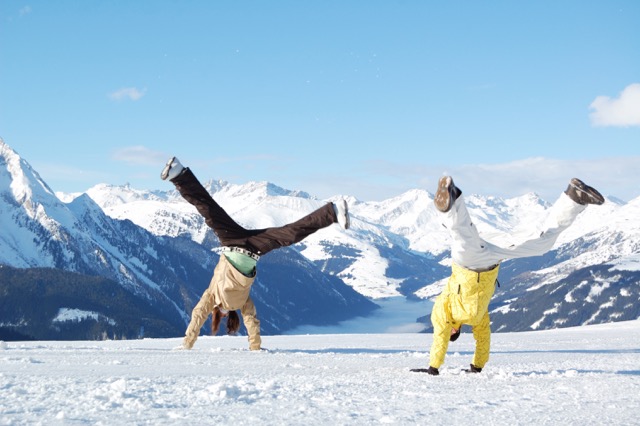Winter can be an exhilarating time to exercise outdoors. Snow-capped mountains, glistening hillsides, and crisp cool air are enticing. Moreover, winter weather often drives people into the gym, so you’re likely to have the trail to yourself. Cold temperatures, snow and ice all pose risks you need to prepare for.
Keys to winter safety on the trail
• Wear suitable clothing
• Wear all terrain or light hiking shoes
• Limit your time outdoors if you’re not conditioned for the cold—don’t stay out all day
• Have a change of clothes for after your workout
• Have access to a shelter
• Choose alternate routes if your regular route seems risky. Consider shorter loops, rather than traveling far from your starting point.
• Wear brightly colored clothing to be visible to drivers
• Use caution on snow-covered surfaces, which may be hiding obstacles—pinecones, rocks—underneath
• Carry a cell phone
Know the Warning Signs
Maintaining your body heat is the first priority in cold weather exercise. If you keep a healthy core temperature, the cold around you will have little effect on either your health or your performance. A drop in core temperature can lead to hypothermia, which is when your body begins to generate heat by excessive muscular oscillation.
Hypothermia is marked by these symptoms:
• Shivering
• Cold feeling to the core, with goose bumps, then confusion and numbing
• Loss of coordination and sluggishness
• Difficulty speaking, mental confusion and stumbling
• Unconsciousness
Dress Right for the Elements
Dressing appropriately is the best defense against a drop in your body temperature, and the ticket to a great workout in chilly weather. Cold-weather dressing is all about layers and fabrics. Avoid wearing cotton, which loses up to 80 percent of its insulating capabilities when it’s wet. Cotton clothes can actually contribute to hypothermia. Technical fabrics are created specifically to function in cold temperatures.
Follow these guidelines for maintaining your core temperature and protecting your body in cold weather:
• Layer clothing: Several thin layers work better than one heavy layer. Layers are also easier to add or remove to regulate temperature. The goal is to keep warm, minimize sweating, and avoid shivering
• Cover your head: Up to 50 percent of body heat can be lost through your head. Always wear a hat or headband.
• Wear gloves: To insulate and protect your hands, choose lightweight gloves that provide the greatest warmth and flexibility, preferably with rubberized or leather strips on the palm for gripping props.
• Cover your mouth: A scarf or mask will help to warm the air before you breathe it. This is especially important if you have respiratory problems, such as asthma, which are irritated by cold air.
• Stay dry: Wet, damp clothing—from either perspiration or precipitation—significantly increases heat loss.
• Keep your feet dry: Choose socks made of polypropylene, wool or another fabric that wicks moisture and retains insulation when the feet get wet.
• Wear sunglasses: Select lightweight shields with UVA and UVB protection. Some styles have interchangeable lenses for sunlight, flat light and foggy conditions.
• Stay hydrated: Dehydration affects the body’s ability to regulate heat. Fluids—especially water—are as important in cold weather as in hot weather. Avoid alcohol and caffeine, which dehydrate your system and constrict your blood vessels.
Cold Weather Safety Tip
Perhaps the most hazardous part of cold weather workout is post workout, when your body is cooling down. Problems with chilling can arise due to wet skin from perspiration, while the blood vessels in the skin continue to dilate to dissipate heat. It is potentially dangerous because this is when the body feels warm and most people don’t feel the need to bundle up. If you are not heading home right away, always have a change of clothing available. The effects of chilling from wet clothing and wet skin come on rapidly and are difficult to abate without a hot shower or bath.
Rain
There’s no reason to halt your workout because of rain. In the event of a showery, wet day, you’ll need to take some extra precautions. Consider the effect of the rain on the route you’ve planned, and make a change if you think the conditions will be too slippery. (Even in warm weather, rain can make a surface slick). Pay extra attention to wet leaves, twigs, and rocks on the path.
Quick Tip About Rain: Time and time again, I’ve seen clients begin their session a little intimidated by the rain. After the warm up they’ve forgotten it’s raining—by the cool down all I see are sets of teeth, smiling. The sense of accomplishment is overwhelming, the feeling is invigorating, and the outcome is right on track! I liken workouts in the rain to jumping into the pool. The first couple of minutes take some getting used to. The rest—you forget you’re wet!
Wind
You might not give a second thought to the effects of a wind on your workout, but windy conditions can bring about many changes and new obstacles to your route. Be sure to wear sunglasses or other protective eyewear, since blowing dust, dirt and sand can spoil a session. Watch closely for debris on your path, from small twigs to branches and pine cones. Dress to protect yourself against the wind—wind chill accelerates cooling, so make sure to add layers if its already cool outside. Familiarize yourself with a wind barrier—a large tree or a wall—to use as a shield if the wind conditions become severe.
Back To Blog

